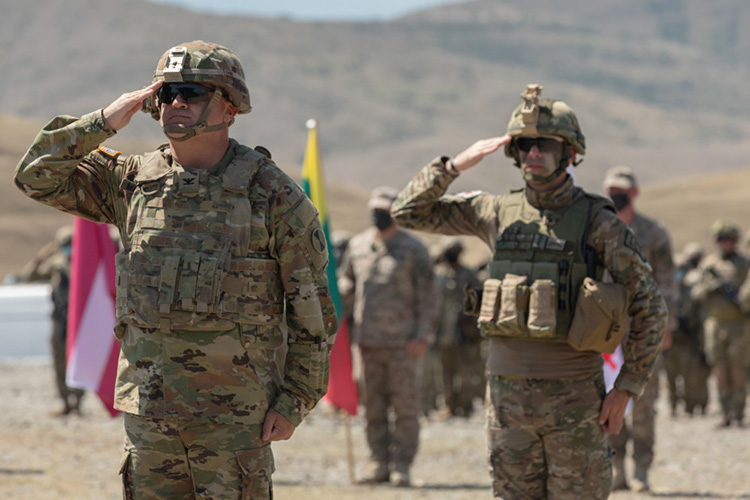Surveillance snapshot: Illness and injury burdens, reserve component, U.S. Armed Forces, 2020
 U.S. Army Col. Kris Marshall, co-director of Exercise Agile Spirit 2021, salutes during a closing ceremony August 6, 2021 at Orpholo Training Area, Georgia. Agile Spirit 21 promotes regional stability and security, while increasing readiness, strengthening partner capabilities and fostering trust. Agile Spirit provides vital opportunities, not only for multiple U.S. services to work together, but also for integrated, total force training with U.S. Reserve and National Guard units and our partner nations’ militaries to ensure interoperability. (U.S. Army National Guard photo by Cpl. Rydell Tomas)
U.S. Army Col. Kris Marshall, co-director of Exercise Agile Spirit 2021, salutes during a closing ceremony August 6, 2021 at Orpholo Training Area, Georgia. Agile Spirit 21 promotes regional stability and security, while increasing readiness, strengthening partner capabilities and fostering trust. Agile Spirit provides vital opportunities, not only for multiple U.S. services to work together, but also for integrated, total force training with U.S. Reserve and National Guard units and our partner nations’ militaries to ensure interoperability. (U.S. Army National Guard photo by Cpl. Rydell Tomas)
You also may be interested in...
Article
Jun 1, 2019
The natural human sex ratio at birth (male:female) slightly favors males, and altered sex ratios might be indicative of exposure to reproductive hazards.
Article
May 1, 2019
The number of medical evacuations for battle injuries has decreased considerably since 2014. Most medical evacuations in 2018 were attributed to mental health disorders, followed by non-battle injury/poisoning; signs, symptoms, and ill-defined conditions; musculoskeletal disorders; and digestive system disorders.
Article
May 1, 2019
Musculoskeletal disorders and mental health disorders accounted for more than half (52.6%) of all illness- and injury-related ambulatory encounters among active component service members in 2018. Since 2014, the number of ambulatory visits for mental health disorders has decreased, while the numbers of ambulatory visits for musculoskeletal system ...
Article
May 1, 2019
Surveillance Snapshot: Illness and Injury Burdens, Recruit Trainees, Active Component, U.S. Armed Forces, 2018
Article
May 1, 2019
Surveillance Snapshot: Illness and Injury Burdens, Reserve Component, U.S. Armed Forces, 2018
Article
May 1, 2019
Among service members deployed during 2018, injury/poisoning, musculoskeletal diseases, and signs/symptoms accounted for more than half of the total health care burden while deployed. Compared to the distribution of major burden of disease categories documented in garrison, a relatively greater proportion of in-theater medical encounters due to ...
Article
May 1, 2019
As in prior years, mental health disorders, pregnancy-related conditions, and injury/poisoning accounted for the majority (59.8%) of all hospitalizations among active component service members in 2018. However, the hospitalization rate for all causes was the lowest rate in the past 10 years.
Article
May 1, 2019
In 2018, mental health disorders accounted for the largest proportions of the morbidity and healthcare burdens that affected the pediatric and younger adult beneficiary age groups. Among adults aged 45–64 years, musculoskeletal diseases accounted for the most morbidity and healthcare burdens, and among adults aged 65 years or older, cardiovascular ...
Article
May 1, 2019
In 2018, mental health disorders accounted for the largest proportions of the morbidity and healthcare burdens that affected the pediatric and younger adult beneficiary age groups. Among adults aged 45–64 years, musculoskeletal diseases accounted for the most morbidity and health care burdens, and among adults aged 65 years or older, cardiovascular ...
Article
Apr 1, 2019
Risk factors for heat illnesses (HIs) among new soldiers include exercise intensity, environmental conditions at the time of exercise, a high body mass index, and conducting initial entry training during hot and humid weather when recruits are not yet acclimated to physical exertion in heat. This study used data from the Defense Health Agency’s ...
Article
Apr 1, 2019
Among active component service members in 2018, there were 545 incident diagnoses of rhabdomyolysis likely due to exertional rhabdomyolysis, for an unadjusted incidence rate of 42.0 cases per 100,000 person-years. Subgroup-specific rates in 2018 were highest among males, those less than 20 years old, Asian/Pacific Islander service members, Marine ...
Article
Apr 1, 2019
In 2018, there were 578 incident diagnoses of heat stroke and 2,214 incident diagnoses of heat exhaustion among active component service members. The overall crude incidence rates of heat stroke and heat exhaustion diagnoses were 0.45 cases and 1.71 cases per 1,000 person-years, respectively. In 2018, subgroup-specific rates of incident heat stroke ...
Article
Apr 1, 2019
From 2003 through 2018, there were 1,579 incident diagnoses of exertional hyponatremia among active component service members, for a crude overall incidence rate of 7.2 cases per 100,000 person-years (p-yrs). Compared to their respective counterparts, females, those less than 20 years old, and recruit trainees had higher overall incidence rates of ...
Article
Apr 1, 2019
As the most frequently reported vector-borne disease among active component U.S. service members, with an incidence rate of 16 cases per 100,000 person-years in 2011, Lyme disease poses both a challenge to health care providers in the Military Health System and a threat to military readiness. Spread through the bite of an infected blacklegged tick, ...
Article
Mar 1, 2019
Infertility, defined as the inability to achieve a successful pregnancy after 1 year or more of unprotected sexual intercourse or therapeutic donor insemination, affects approximately 15% of all couples. Male infertility is diagnosed when, after testing both partners, reproductive problems have been found in the male. A male factor contributes in part ...
You are leaving Health.mil
The appearance of hyperlinks does not constitute endorsement by the Department of Defense of non-U.S. Government sites or the information, products, or services contained therein. Although the Defense Health Agency may or may not use these sites as additional distribution channels for Department of Defense information, it does not exercise editorial control over all of the information that you may find at these locations. Such links are provided consistent with the stated purpose of this website.
You are leaving Health.mil
View the external links disclaimer.
Last Updated: August 18, 2021